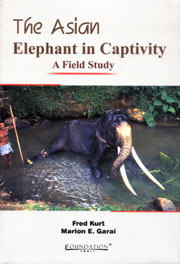Book contents
- Frontmatter
- Contents
- Preface
- Acknowledgments
- 1 Introduction
- 2 The Sri Lankan Elephant
- 3 The Captive Populations, Keeping Systems and Health
- 4 Food, Tool Use and Sleep
- 5 Musth, Reproduction, Social Integration and Stereotypy
- 6 Captive Elephants and Conservation
- 7 Base Lines and Proposals
- Appendix I
- Appendix II
- References
- Photo Gallery
- Index
6 - Captive Elephants and Conservation
Published online by Cambridge University Press: 05 February 2012
- Frontmatter
- Contents
- Preface
- Acknowledgments
- 1 Introduction
- 2 The Sri Lankan Elephant
- 3 The Captive Populations, Keeping Systems and Health
- 4 Food, Tool Use and Sleep
- 5 Musth, Reproduction, Social Integration and Stereotypy
- 6 Captive Elephants and Conservation
- 7 Base Lines and Proposals
- Appendix I
- Appendix II
- References
- Photo Gallery
- Index
Summary
During the meeting of the International Union for Conservation of Nature and Natural Resources (IUCN) Asian Elephant Specialist Group in Phnom Penh in May 2002, the AsESG formed a ‘Captive Elephant Taskforce’. Some AsESG members met again at the Workshop on Captive Elephant Management in Trichur (Oct., 2002) and again the Chairman of AsESG, Professor Dr. Raman Sukumar, asked for ideas concerning the aims of such a taskforce. Together with Khyne U Mar, the former Head of Elephant Research at the Myanma Timber Enterprise, we drafted a few ideas for Gajah the paper of AsESG and for the Smithsonian Institution of Washington (‘Ethics and Elephants’). They included the following thoughts:
The AsESG as well as other agencies should stop to speak of ‘domesticated’ elephants. Misuse of the term ‘domesticated’ leads to the fact that many captive elephants were, and still are, treated as cattle and managed accordingly.
One should ask what are the aims of IUCN and the IUCN Specialist Groups as compared to the aims of animal welfare organisations and zoos which are concerned with management problems of captive elephants, as discussed in the following pages. Then some very brief overviews are given on existing and forthcoming guidelines on the management as well as on the estimated sizes of captive populations. Different aspects of the significance of captive populations are broadly discussed according to the various keeping systems defined in Section 3.2. Finally, some suggestions are made concerning further activities of the AsESG and other conservation agencies in the management of captive elephants.
- Type
- Chapter
- Information
- The Asian Elephant in CaptivityA Field Study, pp. 213 - 239Publisher: Foundation BooksPrint publication year: 2006



